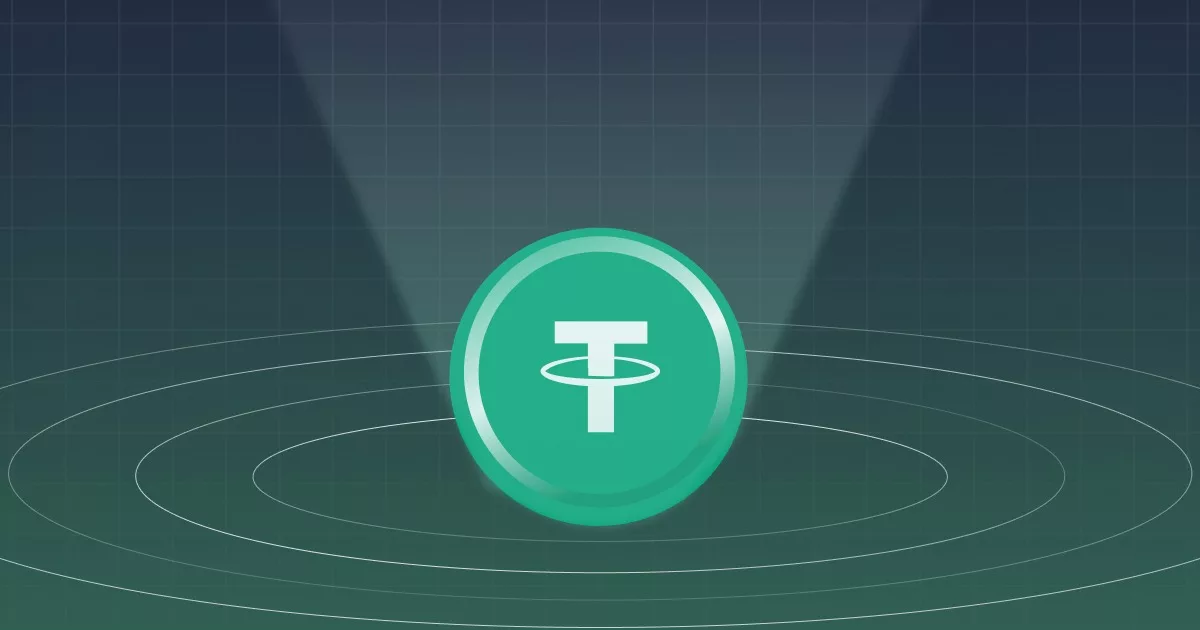
The world of cryptocurrency can be confusing and overwhelming, with thousands of different tokens and coins.
One cryptocurrency that has gained widespread attention in recent years is Tether (USDT). But what exactly is Tether, and why is it so popular among investors and traders?
This comprehensive guide will closely examine what Tether is, how it works, and what makes it special.
What is Tether (USDT)?
For starters, Tether (USDT) is one of the most popular stablecoins.
Now, you might be wondering what a stablecoin is. Well, there are different types of cryptocurrencies, and one of them is a stablecoin.
A stablecoin is a type of cryptocurrency that is designed to maintain a stable value. Unlike other cryptocurrencies, whose value can be very volatile and subject to rapid fluctuations, stablecoins aim to provide a more stable and predictable value.
One way stablecoins achieve this stability is by being pegged to a more stable asset, such as a fiat currency like the US dollar or a commodity like gold. This means that the stablecoin’s value will be tied to the asset value it is pegged to and will not fluctuate as much as other cryptocurrencies. This contrasts with other cryptocurrencies, like Bitcoin or Ethereum, which have highly volatile prices that fluctuate dramatically in hours.
Stablecoins are often used to trade cryptocurrencies without the risk of losing value due to volatility. They can also be used as a store of value for other purposes, such as remittances and payments. Some popular examples of stablecoins include Tether (USDT), USD Coin (USDC), and Dai (DAI).
As Tether is a stablecoin, its stability has made it a popular choice for investors who want to park their funds in a more stable asset.
Tether operates on several blockchain networks, including Ethereum, Tron, and Omni. However, most USDT in circulation is currently issued on the Ethereum blockchain as an ERC-20 token.
Over time, Tether has become one of the most widely used stablecoins in the crypto market, with a capitalization of over 80 billion dollars as of March’23. The popularity of Tether is due in part to its stability, which makes it a valuable tool for traders who want to move funds quickly between different exchanges or to take advantage of arbitrage opportunities.
But Tether is not without controversy. There have been concerns about the transparency of Tether’s reserves and whether the company holds enough US dollars to back all of the USDT tokens in circulation.
Despite these concerns, Tether remains an essential player in the cryptocurrency market. Its stability and liquidity have made it a valuable tool for many traders and investors.
History of Tether
Tether was launched in 2014 by a group of individuals, including Brock Pierce, Reeve Collins, and Craig Sellars.
The initial idea behind Tether was to provide a stablecoin that could be used as a safe haven for traders who wanted to avoid the volatility of other cryptos. Tether accomplishes this by backing each USDT token with an equivalent amount of US dollars held in reserve.
Tether’s history has been marred by controversy and legal issues as follows.
1. November 2017: Security Breach worth USD 31 Million
Tether faced a significant security breach in which $31 million worth of USDT tokens were stolen. Following the theft, a hard fork was implemented.
Tether has also faced criticism over its reserves’ adequacy and access to banking services.
2. April 2019: Tether and BitFinex Accusation
Tether and BitFinex were accused of borrowing at least $700 million from Tether’s reserves to cover BitFinex’s losses, leading to a court order enjoining the companies from further violations of New York law.
The situation was settled in February 2021, with Tether and BitFinex agreeing to pay an $18.5 million fine and discontinue trading with any New York state residents or entities.
3. October 2021: Lack of Sufficient Reserves
Tether was fined $41 million by the US Commodity Futures Trading Commission over claims that its stablecoin was fully backed by US dollars. The settlement revealed that Tether held sufficient fiat reserves to back USDT tokens for only 27.6% of the days in a 26-month sample period from 2016 through 2018.
Despite these issues, Tether has continued to expand, launching stablecoins backed by different fiat currencies, including MXNT, supported by the Mexican peso.
4. May 2022: The Collapse of USDT
USDT’s price dropped to $0.96 due to the collapse of another stablecoin, TerraUSD. Still, it quickly rebounded to over $0.99.
Tether has stated that it continues to honor redemption requests at a 1-to-1 ratio to the US dollar.
How does Tether function?
Tether (USDT) is a stablecoin designed to maintain a stable value relative to the US dollar. To accomplish this, Tether Holdings Limited, the company behind USDT, holds an equivalent amount of US dollars in reserve for every USDT token in circulation.
When someone wants to purchase USDT, they send US dollars to Tether Holdings Limited, which then issues the equivalent amount of USDT tokens to the purchaser. The US dollars received by Tether Holdings Limited are held in reserve to ensure that there are always enough to back the USDT tokens in circulation.
Because USDT is pegged to the US dollar, its value should remain relatively stable. This makes USDT a valuable tool for traders who want to avoid the volatility of other cryptocurrencies.
For example, suppose a trader thinks that the value of Bitcoin is about to decrease. In that case, they can convert their Bitcoin to USDT to “park” their funds in a more stable asset.
Key Features
Tether (USDT) offers several unique features that set it apart from other cryptocurrencies.
1. Stability
The most apparent feature of USDT is its stability, which is achieved through its peg to the US dollar. This stability makes USDT a helpful tool for traders who want to avoid the volatility of other cryptocurrencies.
2. Liquidity
Because USDT is one of the most widely used stablecoins in the cryptocurrency market, it is highly liquid. It can be easily traded on many different exchanges.
3. Accessibility
USDT can be easily purchased and sold on many crypto exchanges, making it accessible to many users.
4. Versatility
USDT can be used for various purposes, from trading and investing to purchasing goods and services. Its stability makes it particularly useful for international transactions, where currency exchange rates can be volatile.
Limitations
Tether (USDT) has the following limitations,
1. Lack of transparency
Tether’s claims of being backed by one-to-one reserves of U.S. dollars have been called into question due to the company’s lack of transparency in providing regular audits.
2. Centralization
Tether is a centralized stablecoin.
It means that a single entity controls its issuance and management. This makes it vulnerable to potential security breaches or operational issues.
3. Counterparty Risk
Holding USDT involves counterparty risk, as users rely on Tether’s ability to maintain the one-to-one reserve of U.S. dollars to redeem their USDT tokens.
If Tether were to face financial difficulties or insolvency, users could potentially lose the value of their USDT holdings.
What makes Tether special?
Tether is special, considering its widespread use in the cryptocurrency market.
As USDT is highly liquid and can be easily traded on many different exchanges, it has become one of the most widely used stablecoins in the market. This has made it a popular choice for traders who want to avoid the volatility of other cryptos.
USDT is also used for remittances, allowing users to send and receive funds across borders quickly and at a lower cost than traditional methods. Its stable value ensures that the recipient receives the correct amount of funds without worrying about currency fluctuations.
It is also used as a means of payment by merchants who want to accept crypto payments without being exposed to price volatility. Using USDT, merchants can receive payments in a stable currency instantly convertible to fiat currency.
Additionally, Tether has been used as a store of value. Some investors and traders hold USDT as a safe haven asset during market volatility or uncertainty.
Conclusion
Tether (USDT) is a unique and exciting cryptocurrency that has garnered much attention recently.
As a stablecoin, it provides stability and predictability not often found in the crypto world. Tether’s ability to maintain a stable price has made it an attractive option for traders and investors looking to park their funds in a more stable asset.
But, concerns about the transparency and legitimacy of Tether’s reserves have led to controversy and scrutiny from regulators and industry experts. As with any investment, it’s essential to research and weighs the risks and benefits before deciding whether to invest in Tether.
Despite the controversy surrounding Tether, it remains a popular and widely used cryptocurrency. Its stability and liquidity have made it an essential part of the broader cryptocurrency ecosystem.
As the world of cryptocurrency continues to evolve and grow, it will be interesting to see how Tether and other stablecoins continue to shape the landscape of digital assets.
FAQs
1. Is Tether a coin or token?
Tether (USDT) is a token operating on blockchains, including Ethereum, Tron, and Omni. It is classified as a stablecoin, as its value is pegged to the US dollar.
For starters, a stablecoin is a type of cryptocurrency designed to maintain a stable value. Unlike other cryptocurrencies, whose value can be very volatile and subject to rapid fluctuations, stablecoins aim to provide a more stable and predictable value.
2. How to buy Tether tokens?
USDT can be easily purchased and sold on many crypto exchanges, making it accessible to many users.
It includes cryptocurrency exchanges like Binance, Kraken, Coinbase, and Mudrex. Users can buy USDT using fiat currencies, such as USD, or other cryptocurrencies like Bitcoin or Ethereum.
3. What is unique about Tether?
Unlike other highly volatile cryptocurrencies, Tether’s value is designed to remain stable. It is a helpful tool for traders and investors seeking to hedge against market fluctuations.
Also, Tether claims to maintain a reserve of real-world assets, such as dollars and euros, to back the value of USDT tokens, which sets it apart from other cryptocurrencies that do not have the same level of backing.
However, this claim has been the subject of controversy and skepticism from some industry experts and regulators.





